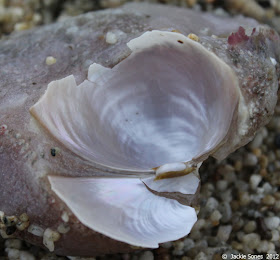Here's a photo from late February. Recent stormy sea conditions made me wonder if more of these might have washed up on local beaches this week.
Two Sea Bottle Clams (Mytilimeria nuttalli) are embedded in a purple tunicate (possibly Cystodytes lobatus?). Normally the clams are completely covered by the tunicate, but here a portion of the tunicate has been torn away, revealing the clams below.
Unlike most clams that live in sandy or rocky substrates, Sea Bottle Clams are usually found living within tunicates (in the low rocky intertidal zone or shallow subtidal areas). While most of the clam is hidden below the surface, they can extend their siphons into the water through a small narrow slit in the outer covering of the tunicate to feed.
These clams may reach 4 cm in length, but individuals ~2 cm long are more common. Their shells are quite thin and fragile — given protection by the tunicate, this clam doesn't need to produce a thicker shell.
The interior of Sea Bottle Clam shells is beautiful and often described as lustrous or pearly (see below).
Although not much is known about their life history, it's thought that juvenile Sea Bottle Clams attach to a tunicate with a byssal thread (like those used by mussels), and then the tunicate grows up around the young clam.
ADDENDUM (30 March 2012)
Sure enough, during a quick walk on the beach this morning I encountered a few more Sea Bottle Clams. Here are two shots from 30 March.
The first shows the slit through which the siphons are extended (as well as a smaller clam to the right of the slit). The second is another attempt to capture the polished interior (it's better to see this in the field!); it also shows how thin and fragile the shell it.




No comments:
Post a Comment